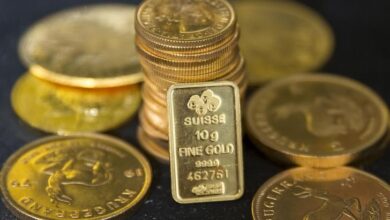Gold prices drop amid waning rate cut bets; Sept nonfarm payrolls awaited

Gold prices fell in Asian trade on Tuesday, extending recent losses as waning confidence in a December interest rate cut by the Federal Reserve supported the dollar and pressured non-yielding assets.
Caution before a long-delayed September nonfarm payrolls reading, which is due this week, also benefited the dollar and weighed on metal prices.
Spot gold fell 0.7% to $4,019.19 an ounce, while gold futures for December slid 1.4% to $4,018.89/oz by 00:38 ET (05:38 GMT).
Gold slides as Dec rate cut bets ease; Sept payrolls on tap
Gold’s losses were triggered chiefly by markets rapidly pricing out expectations for a December interest rate cut by the Fed.
This came amid heightened caution over the U.S. economy, with delays in key official readings, due to a prolonged government shutdown, seen leaving the Fed blind going into the December meeting.
Nonfarm payrolls data for September, due this Thursday, is likely to be the most recent official reading on the labor market before the Fed’s December 10-11 meeting.
CME Fedwatch showed markets pricing in a 42.4% chance for a 25 basis point cut, and a 57.6% chance for a hold.
Higher for longer U.S. rates blunt the appeal of non-yielding assets such as gold, given that Treasuries offer relatively stabler returns in high-rate environments.
Recent comments from Fed officials also offered largely mixed cues on a December rate cut.
Strong dollar pressures metals amid rates, fiscal concerns
Strength in the U.S. dollar, which staged a strong recovery in recent sessions, also pressured metal prices and other commodities priced in the greenback.
Spot platinum fell 0.7% to $1,526.77/oz, while spot silver slid 0.7% to $49.8585/oz. Among industrial metals, benchmark copper futures on the London Metal Exchange fell 0.8% to $10,695.90 a ton, reversing course from strong gains last week.
The dollar firmed in overnight trade, buoyed chiefly by bets that U.S. interest rates will remain steady for longer.
The greenback also benefited from increasing concerns over stretched fiscal spending in the developed world, especially Japan. A spike in long-term Japanese government bond yields battered the yen and drove more flows to the dollar.





